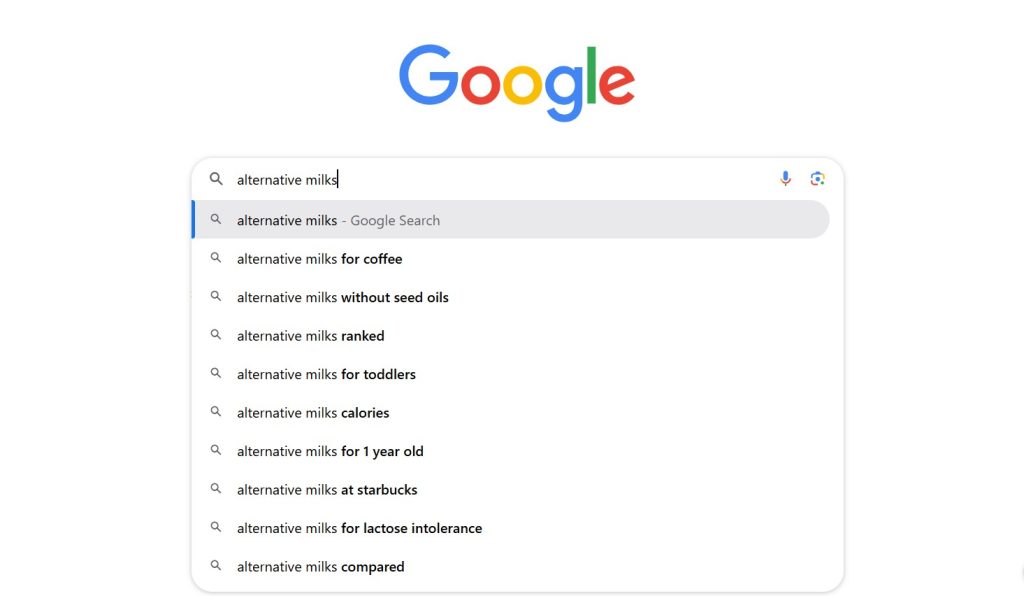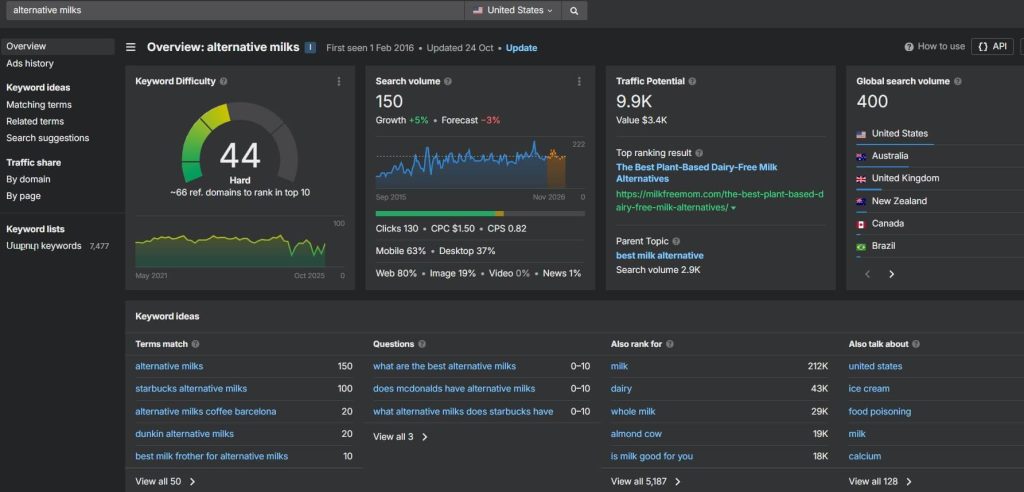Are you thinking about selling online? Or maybe you already have an online store but are having trouble attracting customers?
Don’t assume that your products aren’t worth buying. Often, the problem is just low visibility. If people can’t find your store, they can’t become your customers.
To fix this, you need to improve your online presence by following a straightforward SEO checklist.
We have created a practical ecommerce SEO checklist that outlines the essential steps. This will help you boost your store’s performance in a structured and confident way.
Ecommerce SEO Checklist: 5 Core Steps to Follow
Here are five effective ecommerce SEO checklist steps you must keep in mind to boost your ecommerce store’s online presence:
Keyword Research
The first important step is to identify what your potential customers are actually looking for. To do so, you need to conduct a thorough keyword research and see what they are searching for online, what keywords and phrases they use when searching.
One way is to go to Google and simply type in relevant keywords for your product or service and see what other search results are also popping up.
Let’s say you are running an alternative milk store online. By typing a general “alternative milks” keyword, you will also find out that your potential customers are looking for “alternative milks for coffee” or “without seed oils”.

These insights will help you find content gaps and refine your content strategy by:
- Creating product pages/ product info for high purchase-intent keywords
- Writing blog posts for informational searches
For more thorough keyword research, there is a wide selection of SEO tools that you can use. One such tool is Ahrefs. To have an overview of what keywords are ranking on SERPs, follow these simple steps:
Step 1: Go to Ahrefs’ “Keyword Explorer” section
Step 2: Type in some main product keywords
Ahrefs will then suggest a list of other ranking keywords with all the necessary keyword metrics such as their search volumes and keyword difficulties.

Speaking of keyword metrics, when planning your content strategy, focus on long-tail keywords that have a good search volume and low keyword difficulty. This approach gives you a better chance of ranking. Highly competitive keywords are harder to win and are often dominated by larger, established sites. By prioritizing these easier keywords, you can steadily attract targeted traffic and build authority over time.
You might also want to see how your competitors are doing on SERPs.
Here too, tools like Ahrefs can help you. On Ahrefs:
Step 1: Go to the “Site Explorer” section,
Step 2: Type your competitor’s domain.
Step 3: Go to “Organic Keywords” to see which keywords send traffic to their site.
Now that you have an understanding of what keywords your competitors are ranking for, you can adjust your content accordingly and try to outrank them.
In the long run, conducting deep keyword research will help you attract new customers and increase your sales.
On-Page SEO
Your website is the first thing your customers see and assess as soon as they find out about your product or services. So, it should be properly optimized for search engines.
For an effective on-page SEO optimization, you must ensure these core components:
- Page meta tags: Make sure your webpage’s meta title and description are short enough. For meta titles, stick to 50-60 characters, while for meta descriptions, the general rule is 150 to 160 characters. This way, your full meta tags will be seen on SERP results. Make sure they are also engaging enough for users to click and go to your website.
- Page URLs: Keep your product page URLs short and precise. Avoid excessively long links with numbers or codes. For example, instead of /oatmilk?1245, make sure your URL appears like this: /organic-oat-milk.
If you’re ready to sell, you can start a Shopify store to put these pages into action efficiently.
- Images: Make sure your site includes high-quality, clear images that showcase your products well. At the same time, avoid using files that are too large, as they can slow down your website. To keep fast loading times without losing quality, use online image compressors or optimization tools.
- Internal links: Don’t forget to include internal links on your product and category pages. In your blog posts, make sure to link relevant articles to the corresponding product pages. This not only improves site navigation for users but also helps distribute SEO value across your website.
- Store Sitemap and Robots.txt: Ensure your website has a clear sitemap and a properly set up robots.txt file. A sitemap acts as a roadmap for search engines, showing all the important pages on your store so they can be easily found and indexed. The robots.txt file informs search engines about which pages to crawl and which to ignore, preventing unnecessary or duplicate pages from being indexed. Together, these tools help search engines understand your website structure and make sure the right pages show up in search results.
- Schema Markup: Adding schema markup to your product pages provides search engines with extra information about your products, such as price, availability, and reviews. You can also include information about your FAQ sections and blog post structures. This can later increase the chance of clicks. For businesses that want professional guidance, e-commerce SEO services can help implement these on-page optimizations efficiently and ensure your store follows best practices.
Take a look at one of the largest e-commerce stores, Amazon. Their short, memorable meta tag, “Spend less, smile more,” grabs attention and makes you want to click and explore more. Additionally, their detailed product categories and clear product descriptions help customers find and understand what they are buying.



Link Building and Off-Page SEO
To boost your online visibility, you must also implement certain steps outside of your website. Therefore, there are certain off-page SEO strategies that you need to keep in mind.
And today, with the rise of technology, incorporating AI in ecommerce can further enhance your outreach and engagement.
Acquiring backlinks from relevant and authoritative sources is perhaps the most important step you should take. Consider writing guest posts for websites from a similar industry or niche to yours, but not your competitors. When approved, make sure to include links that lead back to your website to drive traffic to your website. For stores built on Magento Commerce, these off-page strategies can be especially effective because the platform supports SEO-friendly URLs, structured content, and easy integration with marketing tools.
Bonus: This is an email template you can use when reaching out to the owner or the editor of such a website and offering a guest post service.
Subject: Guest Post Proposal for [Blog Name]
Hi [Recipient’s Name],
I hope you’re doing well! I’ve been following [Blog Name] and really enjoy your content on [specific topic, e.g., plant-based lifestyles, vegan recipes, sustainable living].
I’d love to contribute a guest article that I think your readers would find valuable. Some topic ideas I had in mind:
- [Topic Idea 1]
- [Topic Idea 2]
The article would be well-researched, original, and tailored to your audience. I’d also include a natural link to a relevant resource or product page from my website [your store URL], if appropriate.
If this sounds interesting, I’d be happy to draft the full article for your review. Please let me know if there’s a specific style, format, or topic you prefer.
Looking forward to your thoughts!
Best regards,
Don’t underestimate the power of social media. Stay active on your platforms and regularly promote your products and your store. Consider working with bloggers, influencers, or industry experts and ask them to review your products, including links to your website.
Your customers can be your best advocates. Encourage them to leave reviews and share referrals on external sites. To motivate participation, you might offer incentives like special discounts or product samples for each review submitted.
Content Strategy
One of the best strategies to keep your potential customers longer on your website is to have engaging content. It can serve as a hook to keep them interested and make a purchase.
There are several components for a successful content strategy you can implement:
- Blog posts: Take your time to create informative and engaging blog content about your products and industry. Use the main keywords you found earlier. Make sure they fit naturally in your articles, especially in titles and headings. Include internal links to related product pages. Add clear calls to action to encourage readers to keep browsing or make a purchase. Applying Shopify SEO best practices to your blog posts and product descriptions can help your store rank higher and attract more targeted traffic.
- Unique and engaging product descriptions: Describe your products in a way that feels fresh and appealing. Avoid using text from manufacturers or directly copying online content. Focus on highlighting the benefits and key features of each product. Explain what makes each item valuable to the customer.
Product comparisons and guides: Provide educational content that helps your audience understand how to use your products, why they are useful, or how they compare to alternatives. Include product guides, instructions, recipes, and well-researched comparisons of similar products. Ensure this content matches the search intent of your audience, so it meets them where they are in their decision process.
- Customer reviews: Create a dedicated page on your website to show customer reviews, testimonials, and case studies. This builds trust in your products and helps new visitors feel more sure about making a purchase.
- FAQs: People often search online for answers to their questions. Therefore, it’s important to have a frequently asked questions section on your website. This directly addresses common concerns and shows search engines that your site offers useful and relevant information. A good FAQ section can enhance user experience and support your overall search visibility.
Again, remember the power of social media strategy and consider sharing your content across your social media platforms. You can also share informative videos, infographics, or podcasts to keep your content fresh and updated.

Image Source: Freepik.com
User Experience and Engagement
Not only your website content, but the website in general should keep your visitors engaged. The user experience should be smooth and targeted. To ensure a user-friendly experience, keep these components in mind:
- Clear and targeted calls-to-action (CTAs): This means that each product page of your website contains clear CTAs suggesting that visitors learn more about the product, add it to the cart, or subscribe to your newsletter. For a more direct shopping experience, consider integrating a WhatsApp eCommerce Store, allowing customers to browse products and make purchases instantly through the messaging app.
- Smooth checkout process: If your visitors experience complicated or confusing checkout processes, the bounce rates will rise. So make sure the checkout process, such as for example filling in their payment information, is easy, fast, and secure. Using a B2B commerce platform can help streamline complex ordering processes, manage bulk purchases, and provide a tailored experience for business clients.
- Easy site navigation: More importantly, ensure a smooth and user-friendly navigation between website pages. Categories, filters, and menus should be clear and simple enough to use. This is also important in terms of ecommerce site search, so that your visitors should never feel lost or frustrated when trying to find a product.
A fast and easy-to-use site improves user experience and helps search engines index your content better.
To Wrap Up
Today, thousands of different products and services are sold online, making ecommerce very competitive. Even the best products can go unnoticed without the right online visibility tactics.
By taking a step-by-step approach, such as conducting keyword research, optimizing on-page and off-page SEO, refining your content strategy, and ensuring a smooth user experience, you can give your store the advantage it needs.
Use this guide as a roadmap to boost your ecommerce presence, attract more visitors, and convert them into loyal customers.
